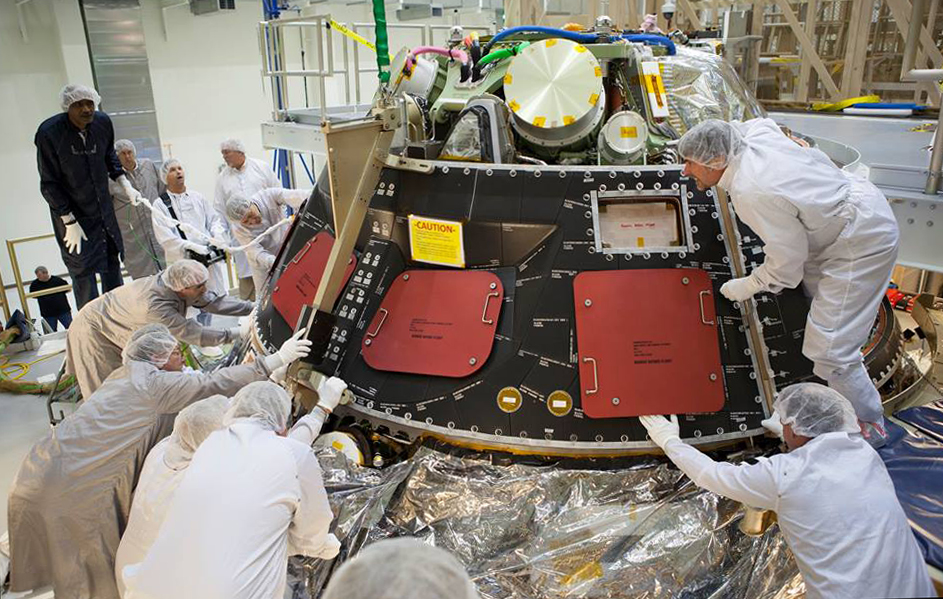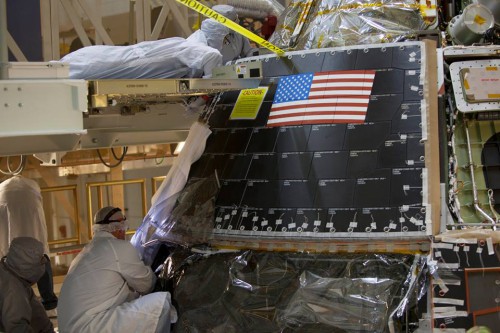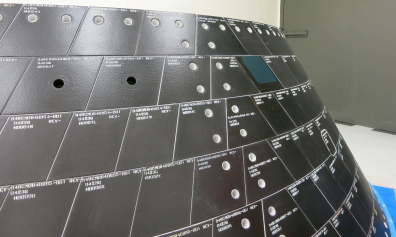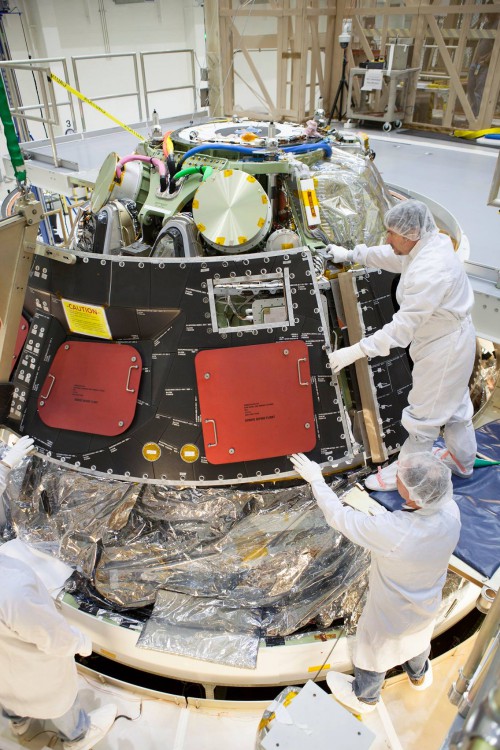
Things are moving forward nicely at NASA’s Kennedy Space Center Operations and Checkout Building in Florida, where technicians with Lockheed Martin (Orion’s prime contractor) are working hard to ready the agency’s Orion spacecraft for its maiden voyage next December. The flight, Exploration Flight Test-1 (EFT-1 for short), will put the unmanned capsule in action to evaluate its launch and high speed re-entry systems, such as avionics, attitude control, parachutes, computers, software, guidance and control, the separation events, and the critical heat shield, and last week the team preparing Orion to fly installed the 970 tiles that make up the spacecraft’s protective cone-shaped back shell.
If the black tiles, which are CNC machined into the proper shapes, look familiar, that’s because they are the same as was used to protect the belly of NASA’s now-retired space shuttles during their fiery reentries through Earth’s atmosphere. However, Orion is made for deep-space exploration, not low-Earth orbit missions like the shuttles, and so Orion will hit Earth’s atmosphere on reentry much faster than the space shuttle did.

The shuttles hit the atmosphere on reentry at around 17,000 mph; when Orion returns on the EFT-1 mission it will hit the atmosphere at 20,000 mph, bringing hotter reentry temperatures to go with its faster velocity. So even though the hottest the space shuttle tiles got was about 2,300 degrees Fahrenheit, the Orion back shell could get up to 3,150 degrees, despite being in a cooler area of the vehicle compared to its ablative heat shield, which is now installed at the bottom of the spacecraft and may experience temperatures of up to 4,000 degrees.
One of the lesser known tests for the upcoming EFT-1 flight will demonstrate Orion’s ability to operate after sustaining damage from a micrometeoroid hit. After the loss of Space Shuttle Columbia in 2003, which was caused by debris from the external fuel tank striking the orbiter’s wing leading edge, NASA learned how to repair tiles in space. Although a lot of information was collected on what amount of damage warranted a repair, the punishing environment Orion will experience on its 4-miles-per-second reentry is much different than the shuttle’s was, and so the old shuttle models just don’t apply.
Orion’s violent return to Earth in December will give engineers the chance to verify new models to better understand the heating environment for damage on Orion’s heat shield, which will inform future decisions about what kind of damage may require a repair in space when Orion launches crewed deep-space missions atop NASA’s mammoth Space Launch System (SLS) rocket starting next decade.
Before installing the protective back shell on Orion, engineers purposely drilled 1-inch-wide holes into two tiles on the opposite side of the back shell from Orion’s windows and reaction control system jets. One of the holes is 1.4 inches deep and the other is 1 inch deep, and both are meant to mimic damage from a micrometeoroid hit. Sensors on the vehicle will record how high temperatures climb inside the holes during Orion’s return.

“We want to know how much of the hot gas gets into the bottom of those cavities,” said Joseph Olejniczak, manager of Orion aerosciences. “We have models that estimate how hot it will get to make sure it’s safe to fly, but with the data we’ll gather from these tiles actually coming back through Earth’s atmosphere, we’ll make new models with higher accuracy.”
All of Orion’s avionics components were installed earlier this summer, and engineers have already conducted functional testing on the crew module’s 59 systems—methodically powering them up one by one. Performance testing, where all of the systems work together to operate Orion as a whole, was completed last spring prior to installation of the capsule’s state-of-the-art heat shield.
Orion was stacked atop its service module back in June, but the service module itself will only serve to provide engineers with the chance to test its structural elements during a real flight. The service module simply has no propulsion or power generation capability for EFT-1.

Currently scheduled to launch at 8:03 a.m. EDT on Dec. 4, 2014, Orion will carry out the first flight of a human-rated spacecraft beyond low-Earth orbit (LEO) in nearly 40 years. The upcoming 4.5-hour unmanned EFT-1 flight will launch atop ULA’s mammoth Delta-IV Heavy rocket, America’s biggest and most powerful launcher, which will fly from Cape Canaveral Air Force Station Space Launch Complex-37B to send Orion to orbit the Earth twice while remaining attached to the upper stage of the Delta-IV.
After the first orbit (two hours after liftoff) the vehicle will perform a burn to reach an altitude of more than 3,600 miles—15 times higher than the orbit of the International Space Station and 10 times higher than any human-rated spacecraft has been since 1972, when the crew of Apollo 17 visited the Moon. Orion will then detach from the Delta-IV upper stage and re-enter the Earth’s atmosphere, before parachuting gently into the Pacific Ocean off the west coast United States.
The three huge booster cores that will make up the Delta-IV Heavy launcher are currently in ULA’s Horizontal Integration Facility at the Cape, along with the rocket’s second stage, where ULA’s Delta launch team is conducting the final horizontal processing and getting the launch vehicle ready to go to the launch pad.
The rocket’s upper stage, which will fire after the initial launch to send Orion farther into space than any human spacecraft has gone in four decades, arrived at the Florida launch site by barge last May, along with the spacecraft adapter and 133-foot-long port booster. The two other common core boosters, each powered by a liquid-fueled RS-68 engine capable of producing over 660,000 pounds of thrust, arrived in Florida last March. Once all three boosters are processed and checked they will be moved to Space Launch Complex 37-B and hoisted vertical, which is expected to occur in late September or early October.
“For this mission, we plan to put the launch vehicle on the pad about two months prior to launch,” said ULA spokesperson Jessica Rye. “After the launch vehicle is at the pad, we will do extensive launch vehicle readiness testing, then fuel the launch vehicle with liquid Hydrogen and liquid Oxygen and perform a Wet Dress Rehearsal. Shortly after Wet Dress Rehearsal, Orion will be stacked on top of the Delta IV Heavy Launch vehicle, and a few weeks later we’ll launch.”
“Orion is the product of a very dedicated workforce that believes keeping America first in space exploration is critical,” said Orion Program Manager Mark Geyer. “This flight, not just the launch in Dec. but the work that went into this design, sets us up very well for the next flights, and for eventually getting people into space again.”
AmericaSpace is one of only a few space news outlets providing on-site coverage of the Orion EFT-1 mission, so check back regularly for updates.
Want to keep up-to-date with all things space? Be sure to “Like” AmericaSpace on Facebook and follow us on Twitter: @AmericaSpace
Missions » SLS » EFT-1 »



4 December 2014 . . . “first flight of a human-rated spacecraft beyond low-Earth orbit in nearly 40 years . . . , GREAT NEWS!! I CAN’T WAIT!! GO NASA!!
This is indeed great news. What’s sad is that for so long NASA didn’t put nearly the publicity into Orion that it does into commercial crew. I have been told by multiple sources that NASA HQ instructed JSC and LockMart to “cool it” on Orion publicity. I have friends who, not being space nuts like me, have said that NASA is dead and not doing anything. They are then astonished to hear from me that NASA will be testing Orion this December, that SLS will fly in about 2 1/2 years. I hope with the publicity that EFT-1 generates that this view of NASA as DOA will start to melt-away. Time will tell.